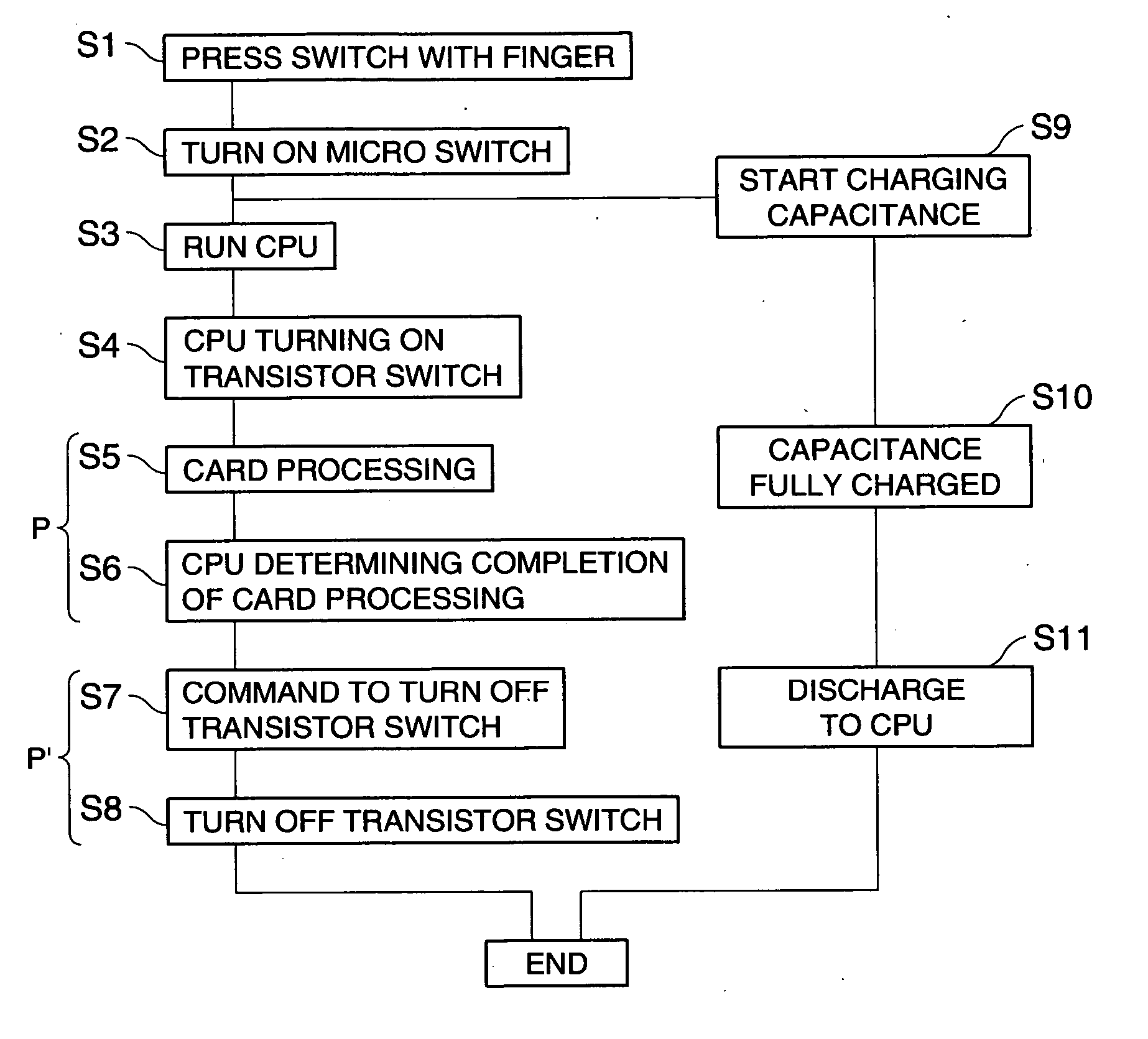Portable information device
a technology of information device and portability, applied in the field of portable information device, can solve the problems of limited power supply, inability to work fingerprint sensors, limited capacity of battery (power source) mountable on this card, etc., and achieve the effects of saving power consumption, driving for longer time, and efficient use of power
- Summary
- Abstract
- Description
- Claims
- Application Information
AI Technical Summary
Benefits of technology
Problems solved by technology
Method used
Image
Examples
first embodiment
[0027]FIG. 1A is a plan view schematically showing the internal structure of an IC card (portable information device) according to a first embodiment of the invention. Referring to the view, this IC card 1 of the present embodiment includes a card substrate 1a, a central processing unit (CPU) 10 for arithmetic operations, a power source 15 coupled to the CPU 10 and serving as a battery to drive the CPU 10, an IC unit 11 controlled by the CPU 10, and a button-shaped micro (μ) switch (mechanical switch) MS that is turned on and off by external inputs. As the micro switch MS, a mechanical switch that is turned on when pressed and turned off when released is used here.
[0028]FIG. 1B is a schematic circuit diagram of the IC card 1 of the present embodiment.
[0029] Referring to the diagram, provided between the power source 15 and the CPU 10 are an external control system circuit 20 that provides power supply from the power source 15 to the CPU 10 while the micro switch MS is pressed, and...
second embodiment
[0055] An IC card according to a second embodiment of the invention will now be described. The IC card of the present embodiment is provided by adding an electronic processing circuit to which power is supplied from the power source 15 under the control of the CPU to the IC card 1 of the first embodiment. Here, like numerals indicate like elements of the IC card 1, and like processes are omitted in a flowchart, which will be described later, and explanation thereof is simplified.
[0056]FIG. 3A is a plan view schematically showing the internal structure of the IC card of the present embodiment. Referring to the view, this IC card 2 includes an encryption unit 60 composed of an electronic processing circuit, which will be described in greater detail later, in addition to the elements of the IC card 1: the CPU 10, the power source 15, the IC unit 11 and the micro switch MS. This encryption unit 60 processes the IC card 2 as mentioned below.
[0057]FIG. 3B is a block diagram showing the ...
third embodiment
[0072] An IC card according to a third embodiment of the invention will now be described.
[0073] The IC card of the present embodiment is provided by adding a fingerprint detection unit 70 to which power is supplied from the power source 15 under the control of the CPU to the IC card 2 of the second embodiment. This unit serves as an identity authentication function device (electronic processing circuit). Here, like numerals indicate like elements of the IC cards 1 and 2, and like processes are omitted in a flowchart, which will be described later, and explanation thereof is simplified.
[0074]FIG. 5A is a plan view schematically showing the internal structure of the IC card of the present embodiment. Referring to the view, this IC card 3 includes a fingerprint detection unit 70 composed of an electronic processing circuit, which will be described in greater detail later, in addition to the elements of the IC card 2: the CPU 10, the power source 15, the IC unit 11, the micro switch M...
PUM
 Login to View More
Login to View More Abstract
Description
Claims
Application Information
 Login to View More
Login to View More - R&D
- Intellectual Property
- Life Sciences
- Materials
- Tech Scout
- Unparalleled Data Quality
- Higher Quality Content
- 60% Fewer Hallucinations
Browse by: Latest US Patents, China's latest patents, Technical Efficacy Thesaurus, Application Domain, Technology Topic, Popular Technical Reports.
© 2025 PatSnap. All rights reserved.Legal|Privacy policy|Modern Slavery Act Transparency Statement|Sitemap|About US| Contact US: help@patsnap.com



